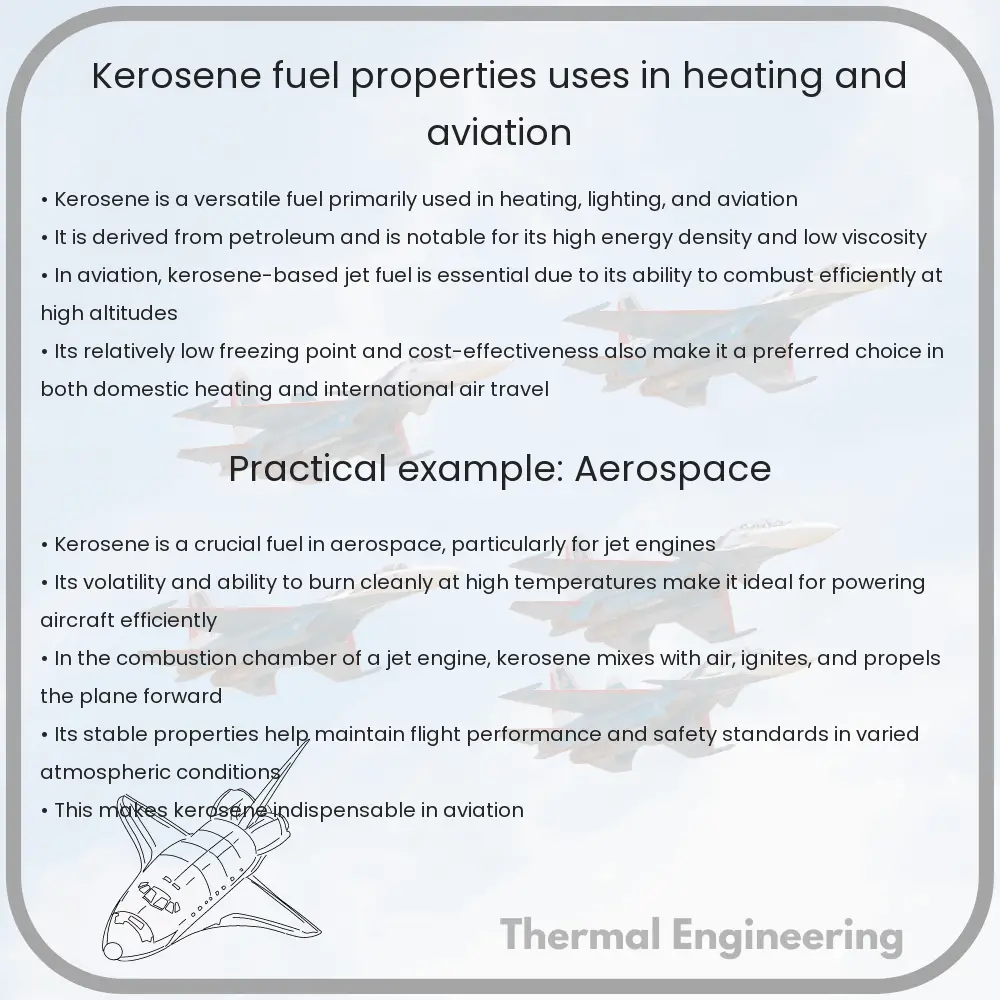Explore the properties, uses, and environmental impact of kerosene, a key hydrocarbon fuel in heating and aviation.

Understanding Kerosene: Fuel Properties and Uses
Kerosene, a versatile hydrocarbon liquid, plays a pivotal role in both domestic and industrial settings. This article delves into the fundamental properties of kerosene, its applications in heating and aviation, and its overall impact on technology and daily life.
Chemical and Physical Properties of Kerosene
Kerosene is a clear, thin liquid derived from petroleum. It typically undergoes distillation to be purified and separated from crude oil between temperatures of 150°C and 275°C. The fuel’s chemical composition mainly consists of carbon and hydrogen, making it a hydrocarbon, with chemical formula ranges often noted as C12H26 through C15H32.
Key physical properties of kerosene include:
- Boiling Point: Ranges between 150°C and 300°C, which makes it less volatile than gasoline.
- Density: Typically around 0.81 kg/L at 20°C, lighter than water which allows it to float on water.
- Flash Point: Approximately 38°C, indicating the lowest temperature at which its vapors can ignite.
- Viscosity: Relatively low, which means it flows easily at normal temperatures.
- Energy Content: Roughly 43.1 MJ/kg, providing a robust source of energy per unit mass.
Uses of Kerosene in Heating
Kerosene is extensively used as a heating fuel in various forms, including in space heaters, lamps, and furnaces. Its ability to store a high amount of energy per volume and its safety in handling make it a favorable choice, especially in regions without access to a continuous electricity supply:
- Space Heaters: Often utilized in portable heating units for homes and garages. Kerosene heaters are known for their efficiency and capability to warm large spaces quickly.
- Lamps: Before the widespread use of electricity, kerosene lamps were a primary source of lighting. Some remote areas still use these lamps.
- Cooking: In some parts of the world, kerosene is used in stoves for cooking, benefitting from its ready availability and portability.
Uses of Kerosene in Aviation
In the aviation industry, kerosene is primarily used in the form of jet fuel, specifically Jet A and Jet A-1. These refined versions of kerosene meet rigorous specifications for burning cleaner and at higher efficiencies suitable for jet engines.
- Jet Engines: Kerosene-based jet fuels are preferred due to their high flash point and lower freeze point, which ensures performance at various altitudes and temperatures.
- Safety: The high flash point of kerosene also reduces the risk of accidental ignitions, an essential safety factor in aviation fuels.
Environmental Impact and Considerations
While kerosene is a necessary fuel in many applications, it is also a fossil fuel, contributing to carbon dioxide emissions when burned. Innovations in fuel technology and increases in fuel efficiency aim to mitigate these environmental impacts. Moreover, the exploration of alternative fuels and energy sources continues to be a crucial area of research in reducing dependency on kerosene and other hydrocarbons.
In conclusion, kerosene remains a critical component in both heating and aviation sectors due to its unique properties and versatility. Ongoing developments in energy efficiency and alternatives are vital to balance its usage with environmental health and sustainability.